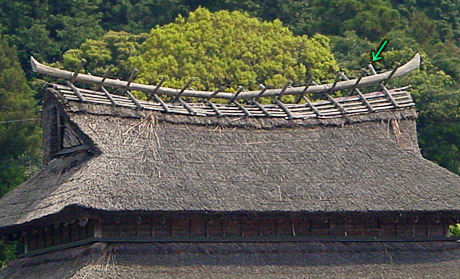|
||
 |
||

*minka 民家 in Shimane prefecture
(C)2001 Japanese Architecture and Art Net Users System. No reproduction or republication without written permission.
掲載のテキスト・写真・イラストなど、全てのコンテンツの無断複製・転載を禁じます。
|
||||||
| karasudomari 烏止まり | ||||||
| KEY WORD : architecture / folk dwellings | ||||||
| Lit. crow's perch. A widely used term for a range
of elements used to decorate the ridge of the roof in vernacular houses *minka
民家 of the Edo period. Its use is recorded in almost all parts of Honshuu 本州,
in Kouchi prefecture (Shikoku 四国), and in northern Kyuushuu 九州. In parts of Miyagi,
Fukushima and Gunma prefectures, it refers to sickle-shaped, decorative timber
elements which are splayed and pointed at both ends, and mounted at either end
of the ridge of the roof. Near Tsuchiura 土浦 in Ibaraki prefecture, and in parts of Shimane,
and Ooita prefectures, it refers to a bamboo pole placed along the ridge of the
roof, as it does also in Kouchi prefecture, but there it spans bundles of straw
set astride the ridge at intervals. In Oono 大野 area of Fukui prefecture it refers to crossed
timber members set astride the ridge at intervals to hold it down. In Tanba
丹波 area of Kyoto, it refers to a long timber pole cradled by forked finials *chigi
千木, and laid along the ridge. In Osaka, it refers to a ridge detailed
with cedar bark, sugikawa 杉皮. In many areas the term was used interchangeably
with suzumedomari 雀止まり, and there are a range of related terms for similar
features, such as *suzumeodori
雀踊り, karasuodoshi 烏おどし, *karasuodori
烏踊り, and *karasutobi 烏鳶. |
||||||
 *minka 民家 in Shimane prefecture
|
||||||
| REFERENCES: | ||||||
| EXTERNAL LINKS: | ||||||
| NOTES: | ||||||
(C)2001 Japanese Architecture and Art Net Users System. No reproduction or republication without written permission. 掲載のテキスト・写真・イラストなど、全てのコンテンツの無断複製・転載を禁じます。 |
||||||